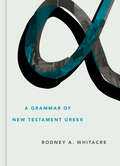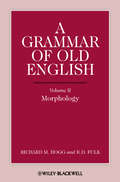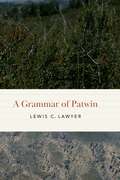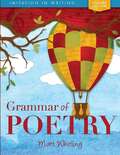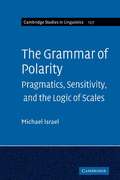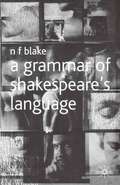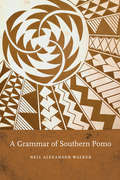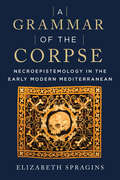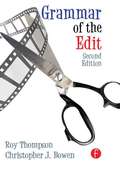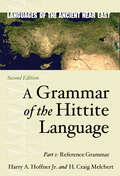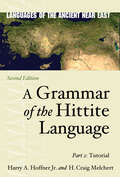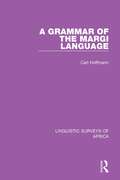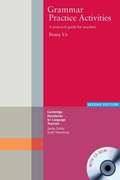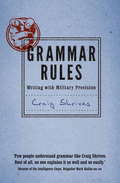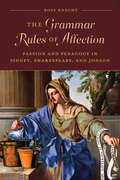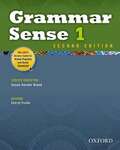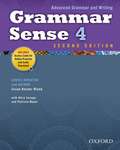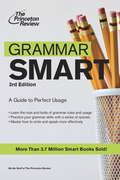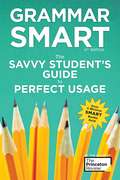- Table View
- List View
A Grammar of Motives
by Kenneth BurkeAbout this book Mr. Burke contributes an introductory and summarizing remark, "What is involved, when we say what people are doing and why they are doing it? An answer to that question is the subject of this book. The book is concerned with the basic forms of thought which, in accordance with the nature of the world as all men necessarily experience it, are exemplified in the attributing of motives. These forms of thought can be embodied profoundly or trivially, truthfully or falsely. They are equally present in systematically elaborated or metaphysical structures, in legal judgments, in poetry and fiction, in political and scientific works, in news and in bits of gossip offered at random."
A Grammar of New Testament Greek (Eerdmans Language Resources)
by Rodney A. WhitacreA reader&’s guide to the morphology and syntax of Koine Greek From the pen of a seasoned instructor of biblical Greek, this book functions as both an essential resource for second-year students and an invaluable asset for all readers as they continue to hone and deepen their linguistic skills. It begins with a basic overview of the language for new learners and for those looking for a brief refresher before moving into nuanced matters of morphology and syntax. Whitacre&’s aim is ultimately to help readers understand the subtleties of the language on the pages of the New Testament; thus, he engages with the biblical text both grammatically and exegetically, so that readers can experience its full power and beauty. Including numerous illustrative examples throughout and several useful appendices at the end, A Grammar of New Testament Greek is indispensable both as a textbook and as a reference for all readers of the Greek New Testament—and other texts written in Koine, such as the Septuagint and the Apostolic Fathers.
A Grammar of Old English, Volume 1: Phonology
by Richard M. HoggFirst published in 1992, A Grammar of Old English, Volume 1: Phonology was a landmark publication that in the intervening years has not been surpassed in its depth of scholarship and usefulness to the field. With the 2011 posthumous publication of Richard M. Hogg’s Volume 2: Morphology, Volume 1 is again in print, now in paperback, so that scholars can own this complete work. Takes account of major developments both in the field of Old English studies and in linguistic theory Takes full advantage of the Dictionary of Old English project at Toronto, and includes full cross-references to the DOE data Fully utilizes work in phonemic and generative theory and related topics Provides material crucial for future research both in diachronic and synchronic phonology and in historical sociolinguistics
A Grammar of Old English, Volume 2: Morphology
by Richard M. Hogg R. D. FulkA Grammar of Old English, Volume II: Morphology completes Richard M. Hogg's two-volume analysis of the sounds and grammatical forms of the Old English language. Incorporates insights derived from the latest theoretical and technological advances, which post-date most Old English grammars Utilizes the databases of the Toronto Dictionary of Old English project - a digital corpus comprising at least one copy of each text surviving in Old English Features separation of diachronic and synchronic considerations in the sometimes complicated analysis of Old English noun morphology Includes extensive bibliographical coverage of Old English morphology
A Grammar of Patwin (Studies in the Native Languages of the Americas)
by Lewis C. LawyerPublished through the Recovering Languages and Literacies of the Americas initiative, supported by the Andrew W. Mellon Foundation. A Native American language formerly spoken in hundreds of communities in the interior of California, Patwin (also known as Wintun Tʼewe) is now spoken by a small but growing number of language revitalizationists and their students. A Grammar of Patwin brings together two hundred years of word lists, notebooks, audio recordings, and manuscripts from archives across the United States and synthesizes this scattered collection into the first published description of the Patwin language. This book shines a light on the knowledge of past speakers and researchers with a clear and well-organized description supported by ample archival evidence. Lewis C. Lawyer addresses the full range of grammatical structure with chapters on phonetics, phonology, nominals, nominal modifiers, spatial terms, verbs, and clauses. At every level of grammatical structure there is notable variation between dialects, and this variation is painstakingly described. An introductory chapter situates the language geographically and historically and also gives a detailed account of previous work on the language and of the archival materials on which the study is based. Throughout the process of writing this book, Lawyer remained in contact with Patwin communities and individuals, who helped to ensure that the content is appropriate from a cultural perspective.
Grammar Of Poetry: Student Edition
by Matt WhitlingThis is the ideal introductory text for students and teachers discovering the art of poetry. As a "grammar," it teaches the fundamentals of poetry from scansion and rhyme to more advanced concepts like spatial poetry and synecdoche. Using the classical methodology of imitation (advocated by educators like Quintilian and Benjamin Franklin), this text makes students become active participants as they learn the craft of writing poems. It also offers practical tips and helps, including how to use a rhyming dictionary, how great writers use figures of speech effectively, and even when to break the rules of poetry. Its goal is to show students how to capably interact not just with poems, but with language in any situation. Developed and used at Logos School with great success, the thirty lessons in Grammar of Poetry contain instruction on ten powerful tropes, student activities for every chapter, riddles to solve, a glossary of terms, a list of over 150 quality poems to integrate, and real-life examples from Shakespeare to traditional tongue twisters. It is designed for a semester at the 6-9th grade level, but is perfectly appropriate for anyone with basic writing skills and the desire to learn poetry.
The Grammar of Polarity
by Michael IsraelMany languages include constructions which are sensitive to the expression of polarity: that is, negative polarity items, which cannot occur in affirmative clauses, and positive polarity items, which cannot occur in negatives. The phenomenon of polarity sensitivity has been an important source of evidence for theories about the mental architecture of grammar over the last fifty years, and to many the oddly dysfunctional sensitivities of polarity items have seemed to support a view of grammar as an encapsulated mental module fundamentally unrelated to other aspects of human cognition or communicative behavior. This book draws on insights from cognitive/functional linguistics and formal semantics to argue that, on the contrary, the grammar of sensitivity is grounded in a very general human cognitive ability to form categories and draw inferences based on scalar alternatives, and in the ways this ability is deployed for rhetorical effects in ordinary interpersonal communication.
A Grammar of Shakespeare’s Language
by N. F. BlakeWhen you read Shakespeare or watch a performance of one of his plays, do you find yourself wondering what it was he actually meant? Do you consult modern editions of Shakespeare's plays only to find that your questions still remain unanswered? A Grammar of Shakespeare's Language, the first comprehensive grammar of Shakespeare's language for over one hundred years, will help you find out exactly what Shakespeare meant. Steering clear of linguistic jargon, Professor Blake provides a detailed analysis of Shakespeare's language. He includes accounts of the morphology and syntax of different parts of speech, as well as highlighting features such as concord, negation, repetition and ellipsis. He treats not only traditional features such as the make-up of clauses, but also how language is used in various forms of conversational exchange, such as forms of address, discourse markers, greetings and farewells. This book will help you to understand much that may have previously seemed difficult or incomprehensible, thus enhancing your enjoyment of his plays.
A Grammar of Southern Pomo
by Neil Alexander WalkerA title in the Recovering Languages and Literacies of the Americas initiative, supported by the Andrew W. Mellon Foundation.A Grammar of Southern Pomo is the first comprehensive description of the Southern Pomo language, which lost its last fluent speaker in 2014. Southern Pomo is one of seven Pomoan languages once spoken in the vicinity of Clear Lake and the Russian River drainage of California. Prior to European contact, a third of all Pomoan peoples spoke Southern Pomo, and descendants of these speakers are scattered across several present-day reservations. These descendants have recently initiated efforts to revitalize the language. The unique culture of Southern Pomo speakers is embedded in the language in several ways. There are separate words for the many different species of oak trees and their different acorns, which were the people&’s staple cuisine. The kinship system is unusually rich both semantically and morphologically, with terms marked for possession, generation, number, and case. Verbs similarly encode the ancient interactions of speakers with their land in more than a dozen directional suffixes indicating specific paths of movement.A Grammar of Southern Pomo sheds new light on a relatively unknown Indigenous California speech community. In many instances Neil Alexander Walker discusses phenomena that are rare or entirely unattested outside the language and challenges long-standing ideas about what human speech communities can create and pass on to children as well as the degree to which culture and place are inextricably woven into language.
A Grammar Of Tariana, From Northwest Amazonia
by Alexandra Y. AikhenvaldThis is a comprehensive reference grammar of Tariana, an endangered Arawak language from a remote region in the northwest Amazonian jungle. Its speakers traditionally marry someone speaking a different language, and as a result most people are fluent in five or six languages. Because of this rampant multilingualism, Tariana combines a number of features inherited from the protolanguage with properties diffused from neighbouring but unrelated Tucanoan languages. Typologically unusual features of the language include: an array of classifiers independent of genders, complex serial verbs, case marking depending on the topicality of a noun, and double marking of case and of number. Tariana has obligatory evidentiality: every sentence contains a special element indicating whether the information was seen, heard, or inferred by the speaker, or whether the speaker acquired it from somebody else. This grammar will be a valuable source-book for linguists and others interested in natural languages.
A Grammar of the Corpse: Necroepistemology in the Early Modern Mediterranean
by Elizabeth SpraginsNo matter when or where one starts telling the story of the battle of al-Qasr al-Kabir (August 4, 1578), the precipitating event for the formation of the Iberian Union, one always stumbles across dead bodies—rotting in the sun on abandoned battlefields, publicly displayed in marketplaces, exhumed and transported for political uses. A Grammar of the Corpse: Necroepistemology in the Early Modern Mediterranean proposes an approach to understanding how dead bodies anchored the construction of knowledge within early modern Mediterranean historiography.A Grammar of the Corpse argues that the presence of the corpse in historical narrative is not incidental. It fills a central gap in testimonial narrative: providing tangible evidence of the narrator’s reliability while provoking an affective response in the audience. The use of corpses as a source of narrative authority mobilizes what cultural historians, philosophers, and social anthropologists have pointed to as the latent power of the dead for generating social and political meaning and knowledge. A Grammar of the Corpse analyzes the literary, semiotic, and epistemological function these bodies serve within text and through language. It finds that corpses are indexically present and yet disturbingly absent, a tension that informs their fraught relationship to their narrators’ own bodies and makes them useful but subversive tools of communication and knowledge.A Grammar of the Corpse complements recent work in medieval and early modern Iberian and Mediterranean studies to account for the confessional, ethnic, linguistic, and political diversity of the region. By reading Arabic texts alongside Portuguese and Spanish accounts of this key event, the book responds to the fundamental provocation of Mediterranean studies to work beyond the linguistic limitations of modern national boundaries.
Grammar of the Edit (2nd edition)
by Roy Thompson Christopher J. BowenLearn the basic "grammar" of editing films and videos in Grammar of the Edit! This book shows you in no uncertain terms (independently of software) what you absolutely need to know to edit your video production. Whether you are just learning how to edit or you need a refresher, this book gives you a basic toolkit to understand the basic terms and the common practices of editing to help create a coherent and meaningful story or visual presentation. This book concentrates on where and how an edit is made and teaches you how to answer the simple question: 'What do I need to do in order to make a good edit between two shots?' Grammar of the Edit begins with an explanation of the basic rules of visual construction that will allow you to arrange your footage logically. The book takes you from the basic vocabulary of editing, to knowing when to cut (and why), to transitions, and finally to good working practices. Designed as an easy-to-use reference, each topic is covered succinctly and is accompanied by clear photographs and diagrams that illustrate the key concepts presented in the book. Simple, elegant, and easy to use, Grammar of the Edit is a staple of any filmmaker's library.
A Grammar of the Hittite Language: Part 1: Reference Grammar (Languages of the Ancient Near East)
by Harry A. Hoffner Jr. H. Craig MelchertSince its publication in 2008, A Grammar of the Hittite Language has been the definitive Hittite reference and teaching tool. This new edition brings Hoffner and Melchert’s essential work up to date, incorporating the dramatic progress achieved in the field over the past fifteen years.Heavily revised and expanded, the second edition recasts the discussion of topics to better serve the linguistically informed reader. A reorganized presentation of the synchronic facts makes them accessible to both Hittitologists and linguists interested in Hittite for historical or typological purposes. Part 1 provides a thorough overview of Hittite grammar that is grounded in abundant textual examples. Part 2 is a tutorial that guides students through a series of graded lessons with illustrative sentences for translation. The tutorial is keyed to the reference grammar and includes extensive updated notes. Taken together with Part 2: Tutorial, which guides students through a series of graded lessons keyed to this reference grammar, the work remains the most comprehensive and detailed Hittite grammar ever produced.
A Grammar of the Hittite Language: Part 2: Tutorial (Languages of the Ancient Near East)
by Harry A. Hoffner Jr. H. Craig MelchertDesigned to accompany A Grammar of the Hittite Language, Part 1: Reference Grammar, this tutorial guides language learners through a series of graded lessons with illustrative sentences for translation drawn from actual Hittite texts. The tutorial is keyed to the reference grammar and provides extensive and updated notes, a vocabulary list for each lesson, and a comprehensive glossary.
A Grammar of the Margi Language (Linguistic Surveys of Africa #2)
by Carl HoffmannOriginally published in 1963, this was, and still is, the only Grammar to be published of the Margi language which is spoken by the people of the Adamawa and Bornu areas of Nigeria. Definitions and explanations ahve been given in as explicitya form as possible, especially where the average student could not be expected to be familiar with the terminology. Numerous examples have been added to illustrate the theoretical explanations.
Grammar Practice Activities: A Practical Guide for Teachers
by Penny UrFirst published in 1988, Grammar Practice Activities is a language teaching classic. This revised version combines tried and tested activities with up-to-date content including a CD-ROM. This is an invaluable resource for any teacher who wishes to combine grammar teaching with a broadly communicative methodology. The book contains a collection of imaginative and interesting grammar practice activities suitable for a wide range of levels and ages. Clear teaching notes accompany each activity ensuring they are easy to use.
Grammar Rules
by Craig ShrivesDo you know how to use semicolons, where to put your apostrophes and when to use commas? Do you know the difference between affect and effect, if and whether, or who and whom? Do you know why this stuff matters? If you've reached a stage in your career or education where your writing needs to be high quality, Grammar for Grown-ups is a must for your top drawer. Vocational rather than academic, Grammar for Grown-ups is packed with real-life examples and keeps you engaged with a wealth of great quotations from Homer the Greek to Homer the Simpson. Straight talking and methodical, Craig Shrives draws on his years as an intelligence officer as well as over a decade spent compiling his popular grammar website to present a comprehensive but light-hearted and easily digestible grammar reference guide.
Grammar Rules: Writing With Military Precision
by Craig ShrivesDo you know how to use semicolons, where to put your apostrophes and when to use commas? Do you know the difference between affect and effect, if and whether, or who and whom? Do you know why this stuff matters? If you've reached a stage in your career or education where your writing needs to be high quality, Grammar for Grown-ups is a must for your top drawer. Vocational rather than academic, Grammar for Grown-ups is packed with real-life examples and keeps you engaged with a wealth of great quotations from Homer the Greek to Homer the Simpson. Straight talking and methodical, Craig Shrives draws on his years as an intelligence officer as well as over a decade spent compiling his popular grammar website to present a comprehensive but light-hearted and easily digestible grammar reference guide.
The Grammar Rules of Affection: Passion and Pedagogy in Sidney, Shakespeare, and Jonson
by Ross KnechtRenaissance writers habitually drew upon the idioms and images of the schoolroom in their depictions of emotional experience. Memorable instances of this tendency include the representation of love as a schoolroom exercise conducted under the disciplinary gaze of the mistress, melancholy as a process of gradual decline like the declension of the noun, and courtship as a practice in which the participants are arranged like the parts of speech in a sentence. The Grammar Rules of Affection explores this synthesis of the affective and the pedagogical in Renaissance literature, analysing examples from major texts by Philip Sidney, William Shakespeare, and Ben Jonson. Drawing on philosophical approaches to emotion, theories of social practice, and the history of education, this book argues that emotions appear in Renaissance literature as conventional, rule-guided practices rather than internal states. This claim represents a novel intervention in the historical study of emotion, departing from the standard approaches to emotions as either corporeal phenomena or mental states. Combining linguistic philosophy and theory of emotion, The Grammar Rules of Affection works to overcome this dualistic crux by locating emotion in the expressions and practices of everyday life.
Grammar Sense 1
by Cheryl PavlikGrammar Sense is a four-level discourse-based grammar series which focuses on the connection between form, meaning, and use of English structures. The series is based on the fundamental premise that English grammar is learnable and teachable if it is systematically organized and explained. Grammar Sense implements linguistic and applied linguistic research on how, where, when, and why native speakers use English structures, and how non-native speakers learn them. This series provides learners with a true understanding of how grammar is used in authentic contexts. Grammar is presented in discourse rather than in isolated sentences which allows the students to understand English grammar in real life situations.
Grammar Sense 4
by Susan KesnerGrammar Sense is a four-level discourse-based grammar series which focuses on the connection between form, meaning, and use of English structures. The series is based on the fundamental premise that English grammar is learnable and teachable if it is systematically organized and explained. Grammar Sense implements linguistic and applied linguistic research on how, where, when, and why native speakers use English structures, and how non-native speakers learn them. This series provides learners with a true understanding of how grammar is used in authentic contexts. Grammar is presented in discourse rather than in isolated sentences which allows the students to understand English grammar in real life situations.
Grammar Smart, 3rd Edition
by Princeton ReviewEverything you need to know to be a grammar guru.This eBook edition is formatted for on-screen viewing with cross-linked questions, answers, and explanations.The words you use say a lot about you. Grammar makes a lasting impression on friends, coworkers, and teachers, but learning the rules has always been notoriously dull. That's why we at The Princeton Review created Grammar Smart! Instead of boring readers with countless rules and confusing grammatical terms, this book uses a witty approach to show the logic behind each correct sentence. This updated third edition of Grammar Smart helps you:* Learn the nuts and bolts of grammar rules and usage* Practice your grammar skills with a series of quizzes* Master how to write and speak more effectively Inside the book, you'll find:* In-depth reviews of the basic parts of speech* Tips on how to avoid misplaced modifiers and dangling participles* A glossary of key grammar terms* Quick quizzes throughout the book to help you check your progress* Detailed sentence diagrams to help you identify word classes* Comprehensive summaries of each major grammar topic
Grammar Smart, 4th Edition: The Savvy Student's Guide to Perfect Usage
by Princeton ReviewTHE KNOWLEDGE YOU NEED TO BE A GRAMMAR GURU.How you speak and write can say a lot about you. Grammar makes a lasting impression, but learning it can seem like a never-ending parade of complicated and contradictory rules! That’s why we at The Princeton Review created Grammar Smart—instead of boring you with countless rules and confusing grammatical terms, this book takes a fun approach to showing the logic behind each correct sentence. This updated fourth edition of Grammar Smart brings you:• In-depth reviews of the basic parts of speech• Tips on how to avoid misplaced modifiers and dangling participles• A glossary of key grammar terms• Quick quizzes throughout the book to help you check your progress• Detailed sentence diagrams to help you identify word classes• Comprehensive summaries of each major grammar topic

